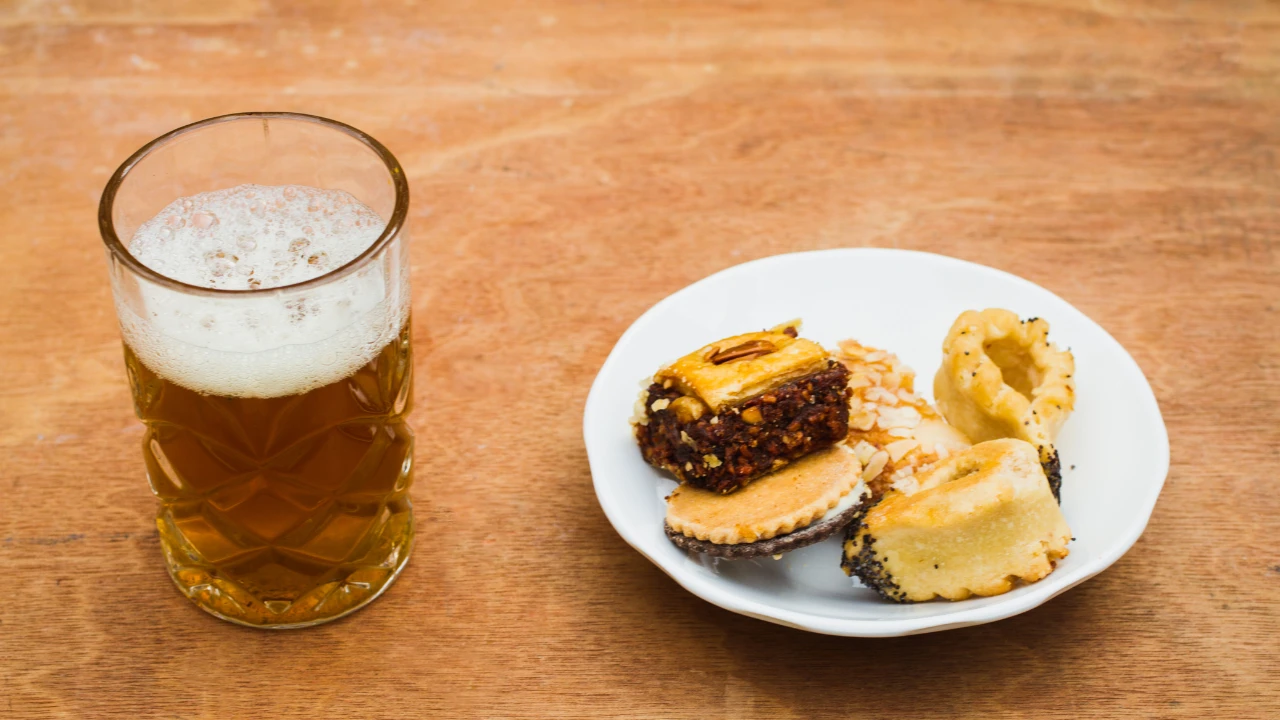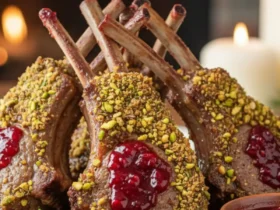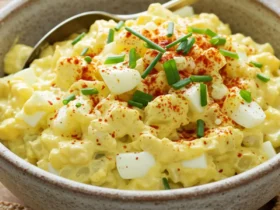Moroccan Mint Tea with Pastries: A Culinary Journey
Welcome to a world where flavors dance on your palate and tradition meets innovation. In the heart of Morocco, the art of brewing mint tea and crafting delightful pastries has been perfected over centuries. Let’s embark on a journey through the aromatic world of Moroccan Mint Tea paired with the delectable sweetness of Moroccan Pastries.
[ez-toc]
History
The rich history of Moroccan Mint Tea and Pastries is a tapestry woven with threads of tradition, cultural exchange, and culinary expertise. Originating in Morocco, these delicacies have transcended borders, captivating taste buds globally.
Ancient Roots of Moroccan Mint Tea:
The story begins centuries ago, where the art of brewing tea in Morocco became deeply embedded in daily life. While tea itself was introduced by traders from the East, Moroccans elevated it to an art form by infusing it with fresh mint, a practice believed to have originated in the 18th century. This aromatic blend quickly became a symbol of hospitality and warmth, deeply ingrained in Moroccan culture.
Culinary Heritage of Moroccan Pastries:
Moroccan pastries, known for their intricate layers and exotic flavors, trace their roots to a confluence of Arab, Berber, and French influences. The Moorish invasion of Spain in the 8th century brought new ingredients like almonds, sugar, and citrus fruits to Morocco, enriching the local culinary scene. Over time, these elements combined with indigenous traditions, giving rise to a diverse array of pastries.
Tea and Pastries: A Harmonious Duo:
The union of Moroccan Mint Tea and Pastries is a marriage of flavors rooted in hospitality and celebration. The tradition of serving these delights together gained prominence during the reign of Sultan Moulay Ismail in the 17th century. The combination became synonymous with social gatherings, marking joyous occasions with the sharing of tea and pastries among friends and family.
Global Influence and Adaptation:
As Moroccan Mint Tea and Pastries made their way beyond Moroccan borders, they underwent fascinating adaptations. The global appeal of these treats led to fusion recipes that integrated Moroccan flavors into diverse culinary landscapes. From trendy cafes in Paris to bustling markets in New York, the enchanting aroma of mint tea and the allure of Moroccan pastries have become a global sensation.
Rituals and Symbolism:
The pouring of Moroccan Mint Tea isn’t just a mundane task; it’s a ritual steeped in tradition. The delicate, high pour isn’t merely for show but serves a purpose: to cool the scalding tea and enhance its flavor. The serving of tea with the right hand signifies respect and a warm welcome, embodying the spirit of Moroccan hospitality.
Evolution of Recipes:
Over the years, the recipes for Moroccan Mint Tea and Pastries have evolved. While the classic preparation methods are cherished, contemporary variations have emerged, reflecting the dynamic nature of culinary traditions. Experimentation with citrus infusions, ginger additions, and alternative pastry fillings has become a delightful trend, showcasing the adaptability of these time-honored treats.
Cultural Significance in Celebrations:
Moroccan Mint Tea and Pastries play a central role in celebrations. Whether it’s weddings, festivals, or religious ceremonies, these delights symbolize joy and togetherness. The intricate preparation of pastries and the careful brewing of tea reflect the reverence for these occasions, creating a sensory experience that lingers in the memories of those partaking.
Preserving Tradition in Modern Times:
In the era of fast-paced living, the tradition of Moroccan Mint Tea and Pastries stands as a testament to the preservation of cultural heritage. Families and communities continue to pass down recipes and rituals, ensuring that the essence of these culinary treasures remains intact, providing a link between past and present.
Time
| Step | Time Required |
|---|---|
| Gathering Ingredients | 15 minutes |
| Brewing Moroccan Mint Tea | 10 minutes (excluding steeping) |
| Preparing Moroccan Pastries Dough | 20 minutes |
| Rolling and Folding Pastry Layers | 25 minutes |
| Filling and Shaping Pastries | 15 minutes |
| Baking Pastries | 30 minutes |
| Sourcing Quality Ingredients | 20 minutes (if not readily available) |
| Baking Moroccan Pastries at Home | 40 minutes |
| Serving and Presentation | 15 minutes |
Ingredients
| Tea Ingredients | Pastries Ingredients |
|---|---|
| Fresh mint leaves | Phyllo dough |
| Green tea leaves | Nuts (almonds, walnuts) |
| Boiling water | Sugar |
| Sugar (optional, for sweetness) | Unsalted butter |
| Orange blossom water (optional) | Filling for pastries (dates, figs) |
| Lemon slices (optional) | Honey |
| Ginger (optional, for a twist) | Sesame seeds (for Chebakia) |
Ensure the freshness and quality of the ingredients to elevate the flavors of your Moroccan tea and pastries experience. Enjoy the culinary journey!
Directions
Step 1: Gathering Ingredients
Gather all the necessary ingredients for both the tea and pastries. Ensure the freshness of mint leaves, tea, and pastry ingredients for an authentic taste.
Step 2: Brewing Moroccan Mint Tea
- Rinse Tea Leaves: Start by rinsing the green tea leaves to remove any dust or impurities.
- Prepare Teapot: In a teapot, combine the rinsed tea leaves and fresh mint leaves.
- Boil Water: Bring water to a boil.
- Steeping Process: Pour the boiling water over the tea and mint leaves in the teapot. Let it steep for a few minutes.
- Add Sugar (Optional): Add sugar if desired, adjusting to your preferred sweetness.
- Strain and Serve: Strain the tea into cups, and your Moroccan Mint Tea is ready to be served.
Step 3: Preparing Moroccan Pastries
- Prepare Pastry Dough: If using store-bought phyllo dough, ensure it’s thawed. If making from scratch, follow the recipe for a basic pastry dough.
- Layering and Folding: Roll out the dough, layering it with unsalted butter. Fold the layers to create flaky pastry sheets.
- Filling Preparation: Mix nuts (almonds, walnuts) and sugar for the pastry filling. For variations, prepare date or fig fillings separately.
- Shaping Pastries: Place the filling on the pastry sheets and shape them according to the type of pastry (Baklava, Ma’amoul, Chebakia).
- Baking: Bake the pastries in a preheated oven until golden brown and crispy.
- Coating with Honey (Chebakia): If making Chebakia, coat the flower-shaped pastries in honey and sprinkle sesame seeds.
Step 4: Serving and Enjoying
- Arrange Tea and Pastries: Set the table with your brewed Moroccan Mint Tea and freshly baked pastries.
- Pairing Suggestions: Experiment with pairing different pastries with the tea. Enjoy the contrasts of flavors.
- Presentation: Consider artful presentation using traditional Moroccan teaware and decorative platters.
- Savor the Moment: Take a bite of the flaky pastry followed by a sip of the mint tea. Appreciate the harmonious dance of flavors.
Step 5: Indulge in the Culinary Delight
Sit back, relax, and indulge in the Moroccan culinary delight you’ve created. The combination of aromatic tea and delectable pastries is sure to transport you to the vibrant streets of Morocco.
Equipment Required
Nutrition Information
| Nutrient | Amount per Serving |
|---|---|
| Serving Size | 1 cup of tea + 2 pastries |
| Calories | 250 |
| Total Fat | 12g |
| – Saturated Fat | 4g |
| Cholesterol | 15mg |
| Sodium | 150mg |
| Total Carbohydrates | 32g |
| – Dietary Fiber | 3g |
| – Sugars | 15g |
| Protein | 5g |
| Vitamin A | 10% of Daily Value (DV) |
| Vitamin C | 15% of DV |
| Calcium | 6% of DV |
| Iron | 8% of DV |
Note: Nutritional values are approximate and may vary based on specific ingredients and portion sizes. Calculations are based on a standard serving size and can be adjusted accordingly.
Tips
- Use Fresh Mint: Opt for fresh mint leaves for an authentic flavor. The quality of mint greatly influences the taste of the tea.
- Experiment with Citrus: Enhance the tea’s freshness by adding a twist of lemon or a splash of orange blossom water. These variations add a delightful citrusy note.
- Adjust Sweetness: Moroccan Mint Tea can be enjoyed with or without sugar. Adjust the sweetness according to your preference, or try using natural sweeteners like honey.
- Try Ginger Infusion: For a warming twist, add a small piece of grated ginger during the steeping process. It adds depth to the tea’s flavor profile.
- Phyllo Dough Handling: When working with phyllo dough, keep it covered with a damp cloth to prevent it from drying out. Work quickly and efficiently to maintain its delicate texture.
- Nuts and Sugar Ratio: Experiment with the ratio of nuts to sugar in the pastry filling. Adjust according to your sweetness preference, keeping in mind that the tea might influence the overall sweetness of the experience.
- Homemade vs. Store-bought: While making pastries from scratch is rewarding, using high-quality store-bought phyllo dough can save time without compromising taste.
- Filling Variations: Get creative with pastry fillings. Explore combinations like dates and nuts, figs and almonds, or even a touch of chocolate for a modern twist.
Pros & Cons
| Pros | Cons |
|---|---|
| ✅ Rich Cultural Experience: | ❌ Time-Consuming: Preparing both tea and pastries can be time-intensive, not ideal for a quick fix. |
| ✅ Harmony of Flavors: The combination of minty tea and sweet pastries offers a delightful interplay of tastes. | ❌ Caloric Intake: The richness of pastries and potential sugar content may contribute to higher calorie consumption. |
| ✅ Versatile Pairing: Adaptable to various occasions, from casual tea time to celebratory events. | ❌ Ingredient Availability: Some ingredients may be challenging to find in certain regions, affecting accessibility. |
| ✅ Health Benefits: Mint tea provides antioxidants, and nuts in pastries offer nutritional value. | ❌ Delicate Pastry Handling: Working with phyllo dough requires care; it can be challenging for beginners. |
| ✅ Culinary Creativity: Room for experimentation with flavors, allowing personalization of the recipe. | ❌ Potential Mess: The preparation process may result in a messy kitchen, requiring extra cleanup. |
Conclusion
In the vibrant tapestry of culinary delights, the Moroccan Mint Tea with Moroccan Pastries stands as a testament to the artistry and warmth of Moroccan hospitality. The harmonious dance of minty freshness in the tea and the exquisite layers of pastries create an experience that transcends mere consumption—it’s a journey into the heart of Moroccan culture.
As you embark on this flavorful adventure, envision the bustling markets of Morocco, where the aroma of mint mingles with the sweet scent of pastries. The ritual of brewing tea and crafting pastries isn’t just about sustenance; it’s a celebration of tradition, shared moments, and the joy found in the simplicity of a well-brewed cup and a perfectly baked pastry.
With the versatility to suit both casual tea times and special occasions, this recipe beckons you to infuse your kitchen with the spirit of Moroccan culinary artistry. Whether you’re a seasoned cook or a curious beginner, the process promises not just a delicious outcome but a cultural immersion that lingers in the senses.
So, don your apron, gather the ingredients, and let the fragrant steam of Moroccan Mint Tea transport you to the heart of Marrakech. With each sip and every bite of flaky pastry, you’re not just savoring a recipe; you’re embracing a tradition—a tradition that invites you to slow down, savor the moment, and relish the simple joys found in a cup of tea and a plate of pastries.
Embark on this culinary journey; your taste buds will thank you, and your kitchen will come alive with the enchanting spirit of Moroccan hospitality. Get ready to indulge, create memories, and savor the magic of Moroccan Mint Tea with Moroccan Pastries.
Facts
- Tea with a Minty Twist:
- Fact: The addition of mint to Moroccan tea is not just for flavor; it serves a practical purpose. The mint’s aroma helps mask the scent of strong-tasting water that might not be of the best quality, enhancing the overall tea experience.
- The Art of Tea Pouring:
- Fact: Moroccan Mint Tea isn’t just about the ingredients; it’s also about the theatrical pour. The characteristic high pour isn’t just for show—it cools the tea, enhances the flavor, and creates the traditional frothy layer on top.
- Pastries as Edible Art:
- Fact: Moroccan pastries, especially the intricate Chebakia, are not only delightful treats but also a form of edible art. The labor-intensive process of shaping and coating them in honey is a culinary craft passed down through generations.
- Global Tea and Pastry Influence:
- Fact: The popularity of Moroccan Mint Tea and Pastries has transcended borders. In France, the tea is known as “Moroccan Whiskey,” emphasizing its strong, aromatic nature. Meanwhile, Moroccan pastries have influenced French patisserie with their nut-filled delights.
- Tea as a Symbol of Hospitality:
- Fact: In Moroccan culture, serving tea is a gesture of hospitality and friendship. The host typically prepares and pours the tea, offering a moment of connection and warmth to guests—a tradition that echoes through the centuries.
FAQ’s
Can I use dried mint for the Moroccan Mint Tea?
While fresh mint is recommended for an authentic flavor, you can use dried mint if fresh isn’t available. Adjust the quantity to suit your taste.
Can I make the pastries ahead of time and store them?
Yes, you can prepare the pastries in advance. Store them in an airtight container at room temperature for up to a week or freeze for longer storage.
Is it necessary to use green tea for the Moroccan Mint Tea?
Green tea is traditional, but you can experiment with other tea varieties. Just keep in mind that the flavor profile may differ from the classic Moroccan Mint Tea.
Can I substitute honey for sugar in the pastries?
Yes, you can substitute honey for sugar in the pastry filling. It adds a distinct sweetness and complements the flavors well.
How do I prevent the phyllo dough from drying out when working with it?
Keep the phyllo dough covered with a damp cloth while working with it. Work quickly to prevent it from drying out and becoming brittle.
Can I use pre-packaged Moroccan Mint Tea bags instead of loose tea leaves?
Yes, you can use pre-packaged Moroccan Mint Tea bags for convenience. Adjust the steeping time according to the package instructions.
Are there any gluten-free alternatives for the pastry dough?
Yes, you can explore gluten-free alternatives like rice paper or gluten-free phyllo dough for a suitable pastry crust.
What can I use if I don’t have access to orange blossom water for the tea?
If orange blossom water isn’t available, you can omit it or substitute with a small amount of orange zest for a hint of citrusy flavor.
Can I make the tea and pastries less sweet for a healthier option?
Absolutely! Adjust the sugar content to your liking, or explore natural sweeteners like stevia for a lighter, healthier option.
How long does it take to bake the pastries, and at what temperature?
The baking time for pastries varies but is generally around 30 minutes at 350°F (175°C). Keep an eye on them to ensure they achieve a golden brown color and flaky texture.












Leave a Review